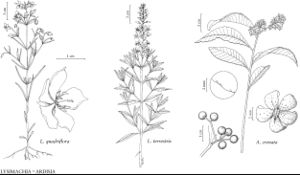Difference between revisions of "Ardisia"
Prodr., 3, 48. 1788, name conserved ,.
imported>Volume Importer |
imported>Volume Importer |
||
| Line 80: | Line 80: | ||
|publication year= | |publication year= | ||
|special status= | |special status= | ||
| − | |source xml=https:// | + | |source xml=https://bitbucket.org/aafc-mbb/fna-data-curation/src/2e0870ddd59836b60bcf96646a41e87ea5a5943a/coarse_grained_fna_xml/V8/V8_637.xml |
|genus=Ardisia | |genus=Ardisia | ||
}}<!-- | }}<!-- | ||
-->[[Category:Treatment]][[Category:Myrsinaceae]] | -->[[Category:Treatment]][[Category:Myrsinaceae]] | ||
Latest revision as of 22:45, 5 November 2020
Subshrubs, shrubs, or trees, not succulent, hairy, glabrescent. Leaves persistent, alternate (pseudoverticillate in A. japonica), monomorphic or dimorphic; petiole present [absent]; blade lanceolate, elliptic, or oblanceolate to obovate, base acute to obovate, margins entire, crenate, or undulate, flat, subrevolute, or revolute, apex obtuse or acute to acuminate, surfaces glabrous and/or with lepidote scales, sessile- or stipitate-stellate hairs, or glandular-villous. Inflorescences terminal, subterminal, axillary, or lateral panicles, racemes, cymes, subumbels, or umbels, sessile (pedunculate in A. japonica), longer than petioles. Pedicels present [absent]. Flowers: sepals 4–5(–6), green, calyx lobes oblong-ovate to ovate, ± equaling tube; petals 4–5(–6), corolla white to pink, cupuliform to campanulate, lobes ± equaling tube, apex acute to acuminate; stamens (4–)5(–6); filaments connate basally into inconspicuous tube, free from corolla tube; stigma punctiform. Fruits drupaceous, globose or subglobose (A. elliptica), sometimes longitudinally costate, 4–8 mm, fleshy (endocarp crusty or slightly bony), indehiscent. Seeds 1, white to black, globose, covered by membranous remnants of placenta. x = 6.
Distribution
Introduced; Mexico, West Indies, Central America, South America, Asia, Indian Ocean Islands (e, se Madagascar), Pacific Islands, Australia.
Discussion
Icacorea Aublet, name rejected
Species ca. 400–500 (4 in the flora).
Selected References
Key
| 1 | Plants subshrubs, stoloniferous, 0.02-0.3(-0.4) m; leaf blade margins serrulate; inflores- cences 3-5-flowered. | Ardisia japonica |
| 1 | Plants subshrubs, shrubs, or trees, not stoloniferous, 1-15.2 m; leaf blade margins crenulate, undulate, or entire; inflorescences 5-18+-flowered | > 2 |
| 2 | Leaf blade margins crenulate or undulate (bearing vascularized nodules). | Ardisia crenata |
| 2 | Leaf blade margins entire (without vascularized nodules) | > 3 |
| 3 | Branchlets glabrous; inflorescences subumbels or umbels. | Ardisia elliptica |
| 3 | Branchlets sparsely to densely rufous-papillate, sometimes also with multicellular hairs; inflorescences panicles of racemes. | Ardisia escallonioides |
